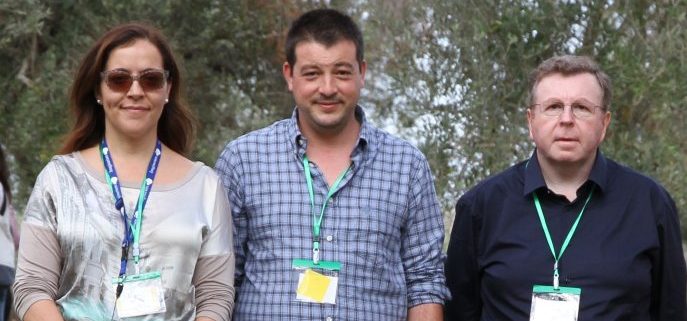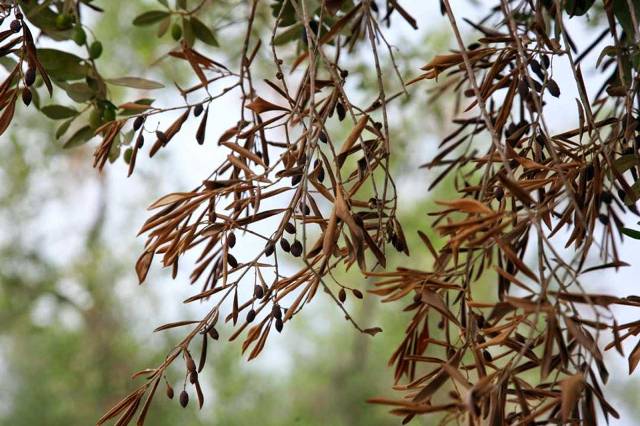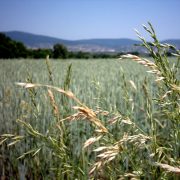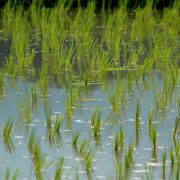Xylella fastidiosa and its current situation in the EU
By Blanca B. Landa del Castillo, Miguel Montes Borrego and Juan A. Navas Cortes, Researchers of the Institute of Sustainable Agriculture (IAS), Consejo Superior de Investigaciones Científicas (CSIC)
Xylella fastidiosa is a Gram-negative xylem resident of very slow and complicated in vitro growth that is transmitted non-specifically by several insect species that feed on the xylem sage and are generically referred to as Cicadélidos and Cercópidos. Its generic name Xylella refers to its location in the wood or vascular tissues of the plant (xylem), while the fastidious species epithet refers to its difficult or ‘fastidious’ growth in laboratory culture medium.
This bacterium has a large number of host plants (more than 350); however, it does not cause visible symptoms in all of them, since it is able to asymptomatically infect several species used as ornamentals or wild plants. Unfortunately, in other cultivated and forest plant species it causes great economic losses and is the causal agent of several diseases, among which we can mention Pierce’s disease of the grapevine, peach dwarfism, and citrus variegated chlorosis, among others. In addition, it also causes many diseases called marginal necrosis or burning in Prunus spp. (Including almond, cherry and plum), oleander, maple, coffee, mulberry, olive, elm, shade banana, various Quercus species (cork, oak and oak), etc.
Xylella fastidiosa presents strains belonging to subspecies and to different genetic types or Sequence Type (ST). This fact is particularly important to understand since each specific subspecies and ST will have a certain range of plant species to which they can infect and in which to cause disease, causing symptoms in them that may be similar or different. For example, several subspecies and strains or TSs may cause similar symptoms in the same host plant as the olive tree, some variants such as the case of subspecies sandyi ST5 only cause disease in oleander, while others such as the fastidious subspecies ST1 cause Disease in alfalfa, vine, almond and cherry, among others.
Given the wide range of diseases and host plants that this bacteria can affect, it does not seem entirely appropriate to call it the “Ebola” of the olive tree, or “phylloxera” of the 21st century, since the capacity to cause devastating diseases will depend of the specific combination of the particular X. fastidiosa strain found in an area, and the genotype or variety of the particular host plant to which it may infect. In addition, adequate environmental conditions must be provided to allow the survival of the bacteria, their multiplication and the development of disease, and there must be an effective vector for their transmission, whose populations are also high in number. Therefore, severe epidemics caused by some specific strains in certain crops do not have to be repeated in another geographical area.
During the last three years, and until now, X. fastidiosa has been detected in four European countries: Italy, France, Germany and Spain
The initial and continued emphasis in the news in Europe on the devastating epidemic outbreak in olive tree that was first detected in October 2013 in the Apulia region of southern Italy is understandable. Until just five years ago, X. fastidiosa had only been detected infecting olive trees in California, USA (X. fastidiosa subsp. Multiplex ST7) and in the regions of La Rioja and Córdoba in Argentina (X. fastidiosa subsp. And the states of Sao Paulo and Minas Gerais in Brazil (X. fastidiosa subsp. Pauca ST16).
In the case of Italy the strain of X. fastidiosa associated with olive belongs to the subspecies pauca and ST53. The disease in olive tree by all the strains previously described is characterized by the presence of chlorosis and burning of the leaves in its margins and drying of shoots and small branches, which begins and prevails in the highest parts of the tree. These symptoms are similar to those produced by the strains found in Argentina, California and Brazil where they do not seem to progress much further. In contrast the strain of Italy is causing the devastation of olive groves belonging to certain varieties and the disease, which occurs quickly, has been called ‘Olive Decay of the Olive’. In this case the mild symptoms initially extend to the rest of the crown, which acquires an ocher or burnish coloration, and in the final stages, trees that already appear ‘skeletons’ emit numerous pacifiers from the base that survive the time it takes they do the roots.
Subsequently the bacterium was detected in France in summer of 2015 in the island of Corsica where it has already been found that it is widely distributed with more than 300 foci identified so far, affecting mainly wild species typical of our Mediterranean flora (with more than 30 Species listed for the moment), in which the multiplex and sandyi subspecies has been detected. In addition, the bacterium has also been detected in more than a dozen foci in the south of the blue coast, belonging in this case to the multiplex and pauca subspecies. Finally, in Germany in April 2016 in a garden center located in the region of Pausa (Saxony) the fastidiosa subspecies was detected infecting plants of oleander, and later it was detected in Rosemary, and in hybrids of Streptocarpus and Erysimum.
The genetic diversity of the different detections of X. fastidiosa carried out in Europe show that these introductions are independent of each other since they are subspecies and strains belonging to different STs. This fact is particularly important to understand since each specific subspecies and TS will have in a range of plant species to which they can colonize and in which they cause different disease, as we have already indicated. Despite this, the media have indiscriminately published that X. fastidiosa ‘has jumped’ from Italy to the Balearics. This information is not correct since the subspecies and strain detected in Italy (X. fastidiosa subsp. Pauca ST53) is different from the strains detected in the island of Mallorca (X. fastidiosa subsp fastidiosa ST1 and X. fastidiosa subsp. STs new to science), and although the strain detected on the island of Ibiza belongs to X. fastidiosa subsp. The stucked ST is different from that of the Apulia region.
All these facts point unequivocally to the fact that X. fastidiosa has been introduced in the Balearic Islands on at least three occasions, if we exclusively adhere to the three subspecies detected to date, without delving into the TS that remain to be characterized.
All recent introductions and establishments of X. fastidiosa in Europe have been greater than originally assumed or expected. One might wonder why this event in Europe is occurring now rather than in the last 100 years. Have not we paid enough attention before ?.
“Our hypothesis is that until Commission Implementation Decision (EU) 2015/789 of 18 May 2015 and its amendments, which oblige all Member States to monitor their territory and demonstrate that they are free of this bacterium, is not when they have begun to appear the various outbreaks”
What is clear is that these new findings make it very likely that in the coming months more outbreaks will be identified, as well as new pathogen genotypes in other regions of Europe and other countries in the Mediterranean Basin. But what is important to emphasize is that precisely having implemented this monitoring measure that contemplates the decision is what will allow to detect outbreaks of the bacterium in the early beginnings, or to be able to curb the expansion of the bacteria in the cases in which have already been established in certain regions.
In this sense, it is unfortunate that the detection in Mallorca has led to the discussion in the media of different autonomous communities about the best strategy to control the outbreak of X. fastidiosa in the Balearic Islands (eradication, containment, etc.) With some more correct comments than others, and unfortunately others very politicized that have been quite unfortunate. It is curious that while it would not be rare for us to have to wait for numerous medical tests and a deep diagnostic analysis for a person to be able to treat or remedy a complicated and serious illness such as cancer, we wonder why It is thought that in the case of the Balearic Islands an immediate decision has to be taken without having materially time to see the degree of ‘metastasis’ of the epidemic.
It is well known that for this bacterium there are still no effective control methods to control the diseases it causes, and that their eradication (ie, total elimination of the bacteria) is only operative in a very localized initial outbreak, whereas it is unlikely that such eradication be effective once it has been established in an area, owing to the wide range of host plants and insect vectors it possesses.
When this bacterium is established, it is necessary to move towards strategies to minimize the impact of damages and to coexist with its presence, as it has been doing for decades in Brazil with citrus and in California with the vine
 In the Balearic Islands in the first focus that was detected at the end of October 2016 in a center of gardening of Porto Cristo proceeded to carry out the actions that contemplates the Decision 2015/789. In this way a radius of 100 meters was drawn to delimit the infected area, where a total of 1,921 guest plants of the diagnosed subspecies (fastidiosa subspecies) were eliminated in accordance with the principle of phytosanitary precaution. In addition, another radius of 10 kilometers was established to delimit the containment zone, in which a systematic mesh of 100 × 100 m was applied, where samples of the plants that had symptoms of X. fastidiosa were taken and all the species were prospected hosts of all subspecies of the bacteria.
In the Balearic Islands in the first focus that was detected at the end of October 2016 in a center of gardening of Porto Cristo proceeded to carry out the actions that contemplates the Decision 2015/789. In this way a radius of 100 meters was drawn to delimit the infected area, where a total of 1,921 guest plants of the diagnosed subspecies (fastidiosa subspecies) were eliminated in accordance with the principle of phytosanitary precaution. In addition, another radius of 10 kilometers was established to delimit the containment zone, in which a systematic mesh of 100 × 100 m was applied, where samples of the plants that had symptoms of X. fastidiosa were taken and all the species were prospected hosts of all subspecies of the bacteria.
In just three months from the confirmation of the initial outbreak, the Plant Health Laboratory of the Balearic Islands has analyzed a large number of plant samples, since in parallel with the sampling carried out in the demarcated area random samples have been collected throughout the archipelago with symptoms similar to those caused by X. fastidiosa. These analyzes have detected more than 100 positive cases not only in the island of Mallorca, but also in those of Ibiza and Menorca.
Obviously, the presence of the bacteria in these islands has not been due to the initial focus of Porto Cristo, as has been indicated in some media in which is blamed for the lack of rapid action in the first focus as the cause of this expansion. There are several evidences that unequivocally cancel this hypothesis: 1) In three months it is improbable that the bacterium extends by such an extensive territory and by diverse islands; 2) They are different subspecies and strains of the bacteria which points to several introductions; 3) Vector populations that can transmit the bacteria in winter are very scarce; 4) The symptoms in olive and almond trees that are associated with plants positive for the bacteria have been observed in the island for several years and were attributed to drought or other pathogens.
Meanwhile, in the Balearic Islands, the combination of measures to eradicate or destroy (start-up) infected trees and containment measures, similar to the measures being taken by our French and Italian neighbors, are being contemplated and include the exhaustive monitoring of all the territory of the Balearic Islands to determine the extent of infection and host plant range, banning movement of plants from the Balearics to any point outside the islands and among them, study of potential insect vectors carrying the bacteria for later control by directed phytosanitary treatments, the study of the surrounding vegetation that can serve as a reservoir for these or the bacteria.
These measures, for the time being, can help prevent or reduce the spread of the disease to neighboring geographic areas or other territories within the peninsula, while as progress is made in obtaining accurate information about the genetic diversity of the bacterium and its specific association with the cultivated and wild plant species of the islands, and on the biology and ecology of the potential vector insects, the search for some mitigation or control measures may be initiated.
For the rest of the Peninsula, Spain has a Contingency Plan prepared by the Ministry of Agriculture and Fisheries, Food and Environment, since 2015 in compliance with the community requirements to prevent the entry and spread in the EU of this bacterium. Among the various actions proposed in the short term are expected to intensify the work of monitoring the territory of the Peninsula, mainly in the geographical areas most at risk from proximity to the Balearic Islands or be areas of increased trade of passengers and goods with them. In this sense, the governments of the different Autonomous Communities are responsible for conducting inspections to ensure that their territory is free of X. fastidiosa, and are carrying out sampling and analysis of plant samples of various kinds to comply with the regulations of Decision 2015/789.
Finally, in the field of research, our institution, the CSIC Institute of Sustainable Agriculture, has participated since the end of 2015 in several international H2020 projects on this pathogen called XF-ACTORS, POnTE, and EUPHRESCO, and which pursue the development of a control strategy Of diseases associated with X. fastidiosa to prevent their entry, establishment and expansion and to contribute to the control of their economic, environmental and social impact in the event of further outbreaks within the EU.

















